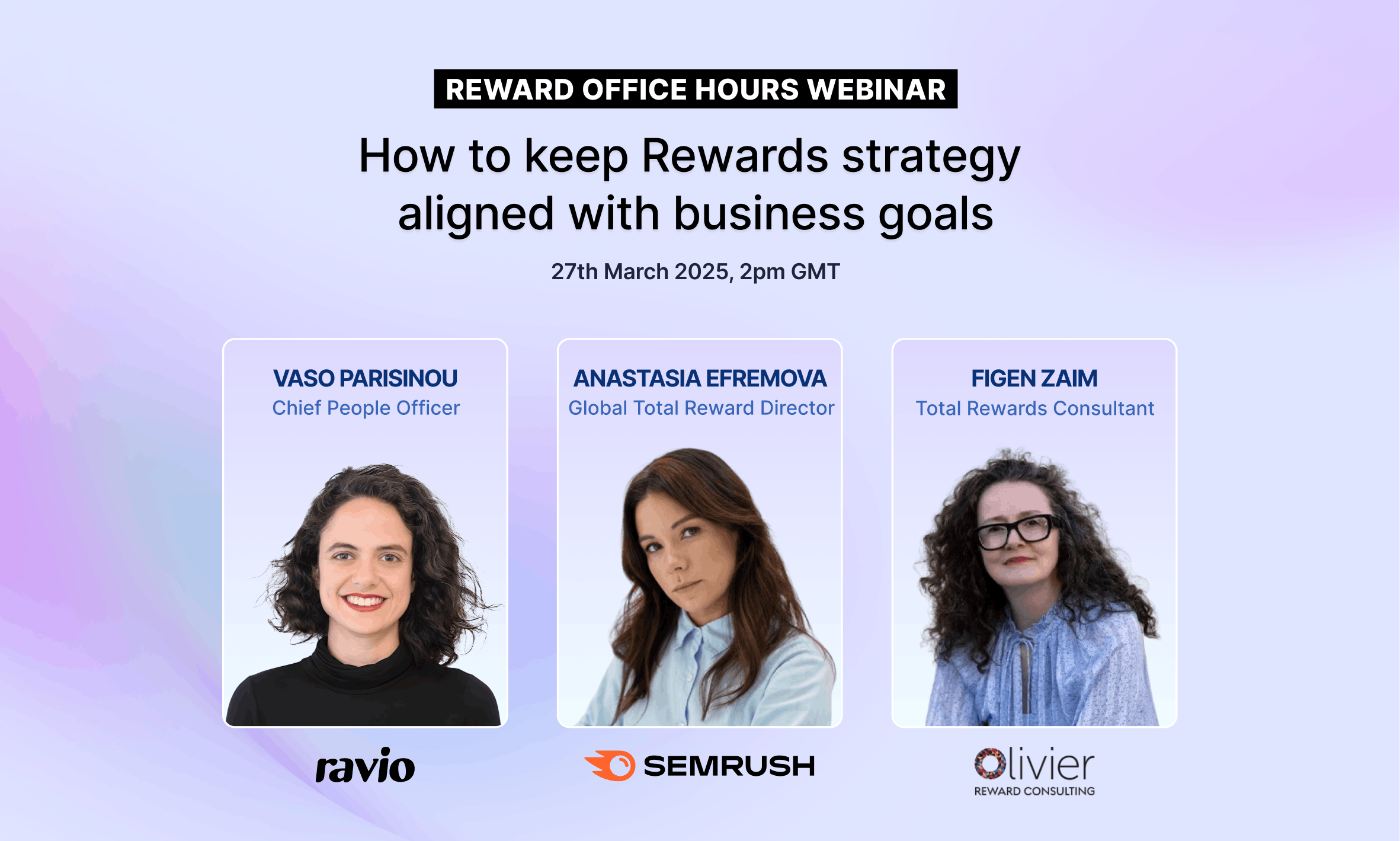Getting buy-in on the strategic importance of Rewards isn’t always easy.
Plus, there’s a lot to balance with Rewards strategy – department leaders with different needs, short-term shifts in macroeconomics, adjusting for new business stages like an IPO, and so on.
For our Reward Community Office Hours in March 2025, Ravio’s Chief People Officer Vaso Parisinou was joined by Anastasia Efremova (Global Total Reward Director at SEMrush) and Figen Zaim (Founder of Olivier Reward Consulting) to discuss this topic of strategic Rewards.
Catch up with the on-demand video recording, and a summary of key takeaways.
Key takeaways from the webinar
If you’re more of a reader than a watcher, here’s a summary of the key takeaways and insights shared during the webinar.
Key takeaway 1: Leadership alignment on Rewards strategy starts with asking stakeholders about their top priorities and worries
CEOs aren’t thinking about ‘engagement’ or ‘talent’, they’re thinking about ‘net income’ or ‘revenue growth’.
The first step to building alignment is to first understand what the priorities, goals, and worries of your leadership stakeholders are. As Vaso put it, “show your leaders that you hear them and empathise with their concerns and what they’re trying to achieve.”
From there, tell stories using data to show how Rewards relates with those top priorities of your leadership stakeholders.
Rewards is the area of HR that’s naturally most closely aligned to business costs and revenue drivers, so it’s usually possible to tie Rewards to business outcomes – whether it’s saving recruitment costs or driving employee performance towards key metrics.
💡Real-world example: Pay equity as a profit driver
Anastasia used the example of pay equity.
Senior leaders might initially think of pay equity as a nice-to-have project or a legal requirement only – not a business priority.
In fact, there’s lots of evidence to suggest that diverse teams increase innovation and, therefore, revenue. Citing this research and demonstrating the business impact can change a leader’s perception.
Key takeaway 2: Getting clear on the company’s DNA is the only way to build an effective Rewards strategy
All three speakers were clear that each company’s Rewards strategy should be unique.
Whilst having a framework or playbook that you use to approach compensation strategy is helpful, it’s crucial that this playbook allows for you to tailor the strategy to the company’s specific context and needs.
As Figen highlighted: “As a consultant I’m constantly asked if we have ‘something quick off the shelf’ that we can implement for a company. That just isn’t how it works, to have the impact you desire, the DNA of the company has to underpin every Rewards decision.”
💡 Suggested diagnostic questions to use when creating or iterating on your Rewards strategy
- What does the company stand for – its North Star mission and core values?
- What are the long-term growth objectives for the business?
- What do you stand for personally as founders or leaders – what are your beliefs about how employees should be compensated?
- How are pay decisions currently made?
- What long-term talent development or organisation structure objectives are there for the business?
Key takeaway 3: When it comes to balancing different Rewards needs within a business, ‘think globally but act locally’
Upholding a Rewards strategy is not an easy task.
Sometimes departments or office locations ask for a specific approach that’s different to elsewhere. Sometimes short-term needs uproot the long-term strategic plan, whether it’s urgent talent needs or macro shifts like Covid-19 that completely change the working environment. Sometimes the company goes through a major change, like restructuring or new leadership or merging with another business.
How to balance all of these competing needs, whilst upholding the core principles and goals of the Rewards strategy, came up as a hugely challenging area.
Anastasia introduced the concept of “thinking globally, but acting locally” i.e. be clear on the overarching strategic framework of how compensation decisions are made, but be flexible enough to make decisions with that framework differently based on ‘local’ needs.
💡 Real-world examples: Localised benefits, sales incentives, crisis pivots
Example 1: Anastasia shared the example that at SEMrush there is a set of core principles across the global business about employee benefits – including that benefits should support the mental and physical health of the team. However, what this looks like varies per office location, because different countries have different healthcare systems and wellness cultures.
Example 2: Vaso shared the example of a sales team asking to introduce a sales incentive plan, whilst variable pay was not typically used across other departments. She highlighted the importance of listening to each department leader to understand their needs, being flexible to build their needs into the Rewards strategy, but also taking the time to instill the core principles and philosophy behind how the company approaches compensation to ensure that this change remains in alignment with the rest of the organisation.
Example 3: Figen emphasises that in times of crisis, such as hyperinflation affecting one of your core markets, the best approach is to pivot quickly, but anchor any changes made to the long-term strategy – maintain the core principles to avoid having to fix a messy situation later.
Key takeaway 4: Reward Leaders are ‘unsung heroes’!
Figen reflected that Reward Leaders are “unsung heroes” who are balancing this strategic view and commercial alignment with very tactical activities like fixing an employee’s payroll issue every day. It’s a never-ending case of competing priorities, and it’s really difficult in that context to be constantly championing the core principles and philosophy behind how compensation decisions are made, to ensure consistency and fairness for all.
Vaso shared that in challenging times she finds “peer-to-peer connections crucial” for “brainstorming ideas and solutions, or even just commiserating about the stress to someone who actually understands what you’re experiencing.”
Whilst our Reward Hours always include a ton of valuable insights from our expert speakers, they’re also an opportunity to bring Reward Leaders together to connect and share their experiences and challenges – and we’re learning just how vital these connections and communities are in the Rewards space.



